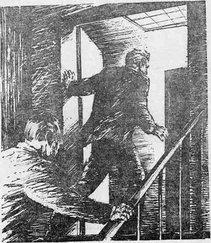Barrel roll: An aerobatic maneuver during which an aircraft is rolled completely around its longitudinal axis. (The longitudinal axis is an imaginary line drawn from the tip of the nose back to the end of the tail.)
Battery cart: A standard piece of ground-support equipment that carries a number of well-charged batteries (under most circumstances). It can be plugged into an aircraft and used to start engines, thereby sparing excess drain on the aircraft’s own internal batteries.
Beeper: A small device that transmits a continuous electronic signal so that it can be easily located.
Belly in: To land an aircraft, usually deliberately, without putting the landing gear down. This is the accepted technique when making forced landings in rough terrain or on water.
Bendix Mixmaster: A very good, but quite complex, octant used during World War II for celestial navigation purposes.
Blind broadcast: A message put out with no assurance that it is being heard by the intended recipient.
Bluie West 8: The World War II code designation for the landing strip located at Söndre Strömfjord, Greenland. It is on the west coast of the island, slightly north of the Arctic Circle.
BMEWS: See Ballistic Missile Early Warning System.
Buddy system: A military regulation that, when in effect, prohibits anyone from venturing out without at least one companion, for mutual protection.
BX: Base Exchange, a military store operated for the benefit of the personnel stationed at a military facility; it normally sells civilian goods at reduced prices.
C-47: The Douglas DC-3 in all of its military variations. It is one of the most memorable aircraft ever built, and one of the best.
C-130: A Lockheed-built, four-engined, turboprop airlifter widely used by the Military Airlift Command, and by the Canadian Armed Forces. It is noted for its short takeoff and landing capability, and for its rugged reliability; its official name is “Hercules.”
C-141: A Lockheed four-engine, jet, heavy airlifter with strategic (long-range) capability. This aircraft is the current backbone of the MAC fleet.
Carburetor beat: A system for deicing carburetor intakes in piston engines that do not have fuel injection. Carburetor ice is a frequent problem, even during good weather conditions, and almost all conventional piston-powered aircraft are equipped with this device.
Checklist: A schedule of items that must be checked and verified before each phase of aircraft operation. Usually there are several checklists, including pre-engine-start, pretaxi, before-takeoff, before-landing, after-landing, and sbutdown. Sometimes long and complicated, checklists are used to insure that no significant items are forgotten or overlooked. Checklists are religiously used during all properly conducted aircraft operations.
Chill factor: An equivalent temperature arrived at by taking into consideration both the actual temperature and the wind velocity. The wind has a major effect in determining the danger of exposure in the Arctic.
Chord: The width of an aircraft wing, measured from the leading (front) to the training (rear) edge. It is almost always greatest at the root, i.e., next to the fuselage or the main body of the aircraft.
Closed field: An airport where all operations are prohibited because of adverse weather conditions. (The term also applies, of course, to airports that have shut down permanently.)
Cocked: A term applied to a large or sophisticated aircraft that has been prepared for flight with all checklist items completed up to “start engines,” or the equivalent. Generally, any aircraft prepared as far as possible for immediate use.
Command post: An especially equipped room, or site, that serves as a headquarters for a specific type of operation. Normally command posts are equipped with communications, display boards, and other facilities.
Cuban 8: A fairly difficult aerobatic maneuver which consists, roughly, of vertical figure 8’s. Cuban 8’s are notoriously prone to induce airsickness in passengers who elect to ride through them.
CW: Continous Wave, or Morse code-type, radio communications.
DEW Line: A series of Distant Early Warning radar stations stretched across the Arctic; there are DEW Line stations on the Greenland Ice Cap, but they are different from, and should not be confused with, BMEWS.
Ditch: To put a land-based aircraft down on water, obviously an emergency procedure only.
DME: Distance Measuring Equipment, an airborne electronic device that can read out the distance in nautical miles from an aircraft to a suitably-equipped (usually TACAN) radio station. A pilot’s dream come true.
Dope: A special compound used to coat aircraft fabric-covered surfaces.
Dorsal: A long, extended fin on the top of an aircraft which leads into the vertical stabilizer.
Double drift: A navigational technique used to determine the strength and direction of the wind. By measuring the observed drift accurately on two different headings, the navigator can make a very close determination of the wind at the altitude at which his aircraft is flying.
Driftmeter: A device by means of which a navigator can determine the drift of an aircraft by sighting the ground or water underneath. Drift, per se, is the amount of sidewise motion induced by the prevailing wind.
Driftpins: Very substantial and heavy steel pins used to fasten the wings onto the main body structure of certain aircraft. They are slightly tapered and usually one to two inches in diameter.
Drink: Aviation slang for “refuel.”
Elevator: A movable surface (or a pair of surfaces) that controls the pitch of an aircraft. It is part of the tail assembly.
Elmendorf A United States Air Force base located near Anchorage, Alaska.
Empennage: The complete tail assembly of an aircraft.
Engine frame: The (usually welded) tube structure that serves as an engine mount on an aircraft. ETA: Estimated Time of Arrival.
FAA: Federal Aviation Agency.
Fairings: Fillets, usually between the wings and fuselage of an aircraft, installed to insure a smooth, minimum-friction flow of air over otherwise awkward areas.
Feather: To turn the blades of an inactive propeller edgewise to the wind to reduce drag and prevent windmilling.
Feathering button: The cockpit control which when depressed will feather a specific propeller.
Field-grade officer: A major or higher.
Fillet : A concave piece of metal used to streamline the meeting of two aircraft surfaces, such as the wing and the side of the fuselage.
Firebee : A pilotless target drone manufactured by Ryan.
Firewall : A solid panel which separates the cockpit from the nose-mounted engine in single-engined aircraft. If there is no nose-mounted engine, the term is still used.
Fittings : The integral parts used to fasten one piece of an aircraft’s structure to another.
Five-square : A code to indicate that communications are both loud and clear. The scale of values used is one to five, for both volume and clarity. Thus three-by-three would indicate marginal volume and also impaired clarity. Five-square is frequently used instead of five-by-five . The two values, of course, need not be the same; a signal could be very faint, but still clear.
Fix : A navigational term designating the exact location of an aircraft in flight at a specific time.
Читать дальше












